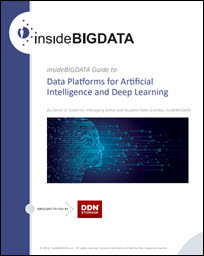
With AI and DL, storage is cornerstone to handling the deluge of data constantly generated in today’s hyperconnected world. It is a vehicle that captures and shares data to create business value. In this technology guide, insideBIGDATA Guide to Data Platforms for Artificial Intelligence and Deep Learning, we’ll see how current implementations for AI and DL applications can be deployed using new storage architectures and protocols specifically designed to deliver data with high-throughput, low-latency and maximum concurrency.
The target audience for the guide is enterprise thought leaders and decision makers who understand that enterprise information is being amassed like never before and that a data platform is both an enabler and accelerator for business innovation.
Characteristics of Storage Solutions Optimized for AI & DL
Achieving successful AI and DL deployments requires ingest, processing and continuous engagement of large and diverse data sets, often at scale. Further, the combination of different concurrent, mixed workloads requires a storage system which can cope with a wide range of workloads. As a result, the characteristics of a data storage solution in support of these types of workflows must be specifically optimized for AI and DL. What’s needed is an AI data platform.
An AI data platform must enable rapid iteration for model training and refreshing. Rapid prototyping, experimentation and refinement of models are critical for achieving best possible yield from neural networks. The AI data platform must enable easy transition of models from training into validation and inference. Seamless transition from development to production enables organizations to quickly leverage and monetize innovation.
Where data is the new source code, the process begins by learning from a very large amount of data. The idea of success for a DL development environment is having access to very large data sets that are meaningful to the problem domain. The size, the quality, the diversity of the data sets are all critical. The AI data platform must be capable of ingesting, handling and delivering heterogeneous data types and mixed workloads simultaneously and without compromise. The AI data platform must scale seamlessly in multiple dimensions—capacity, capability, performance— to match evolving workflow needs. It should provide flexible configuration options to achieve optimal technical and economic benefits for organizations.
There is a balance between technical and economic realities, i.e. you want to be efficient in the way you store your data, you want to be smart about the way you store your data, and you want to spend a lot of time thinking about these realities when you’re defining your infrastructure.
Data protection also is very important. Organizations engaging AI and DL programs incur significant expense to collect data sets. Enterprises need to start thinking about how to accumulate data from multiple sources, heterogeneous types of data, images, text, etc., and hold onto it for an infinite period of time. How can this data be protected? When you’re talking about 10s or 100s of PB over decades, this can raise overwhelming and complex considerations. How can you make sure your data is there when you need it? And maybe even more importantly, how can you organize this data in a way that you can find it again? A thorough data governance plan is a cornerstone for enterprises engaging in AI and DL.
“Data plasticity” for AI and DL is an important notion where data is the lifeblood of the march toward insights (similar to neuroplasticity where the brain is able to reorganize itself). When it comes to AI pipelines, data must be easily molded into forms needed by the application. Once captured, you have a giant pool of very valuable information, and you want to be able to consume it easily, rapidly and in very different forms. AI thinking, making the AI think fast, is accomplished by using large amounts of information and making it accessible faster. The more reliable the access, the better the AI results will be. These are all virtues of a robust AI data platform.
This is the third in a series of articles appearing over the next few weeks where we will explore these topics surrounding data platforms for AI & deep learning:
- Introduction, Data is the New Source Code
- Unique Storage Demands for AI and DL Workloads
- Characteristics of Storage Solutions Optimized for AI & DL
- Accelerated, Any-scale AI Solutions
- Data Storage for AI/DL Case Studies, Summary
If you prefer, the complete insideBIGDATA Guide to Data Platforms for Artificial Intelligence and Deep Learning is available for download from the insideBIGDATA White Paper Library, courtesy of DDN.




Speak Your Mind